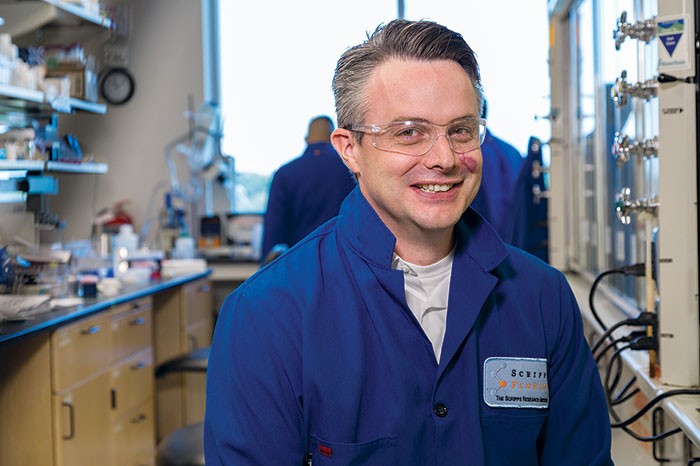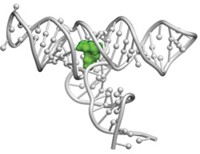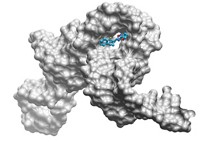Advertisement
Grab your lab coat. Let's get started
Welcome!
Welcome!
Create an account below to get 6 C&EN articles per month, receive newsletters and more - all free.
It seems this is your first time logging in online. Please enter the following information to continue.
As an ACS member you automatically get access to this site. All we need is few more details to create your reading experience.
Not you? Sign in with a different account.
Not you? Sign in with a different account.
ERROR 1
ERROR 1
ERROR 2
ERROR 2
ERROR 2
ERROR 2
ERROR 2
Password and Confirm password must match.
If you have an ACS member number, please enter it here so we can link this account to your membership. (optional)
ERROR 2
ACS values your privacy. By submitting your information, you are gaining access to C&EN and subscribing to our weekly newsletter. We use the information you provide to make your reading experience better, and we will never sell your data to third party members.
Drug Discovery
The RNA drug hunters
Academics, biotech start-ups, and big pharma companies are designing small molecules that target RNA
by Ryan Cross
November 27, 2017
| A version of this story appeared in
Volume 95, Issue 47

Matthew Disney has spent much of the past 12 years countering doubtful, sometimes even dismissive, remarks about his work. Fellow academic researchers said his science was too risky; federal agencies were reluctant to fund it. His friends in industry said there simply weren’t enough data.
Why the skepticism? The Scripps Research Institute Florida chemist has been trying to do something that defies drug discovery dogma: Invent small-molecule drugs that can target RNA.
Almost every pill we take is designed to alter the activity of a protein. That’s because proteins often play lead roles inside cells as messengers, builders, and bulldozers. To perform these tasks, proteins use pockets in their complex three-dimensional structure to respond to, construct, or break down molecules. Drug designers take advantage of these clefts by creating molecules that fit snuggly inside and block or change protein activity.
RNA, on the other hand, is the set of instructions for making proteins. In textbook illustrations, it is often endowed with the same properties as a wet spaghetti noodle—linear, but able to clumsily twist, fold, and stick to itself. That shape doesn’t lend itself to obvious binding pockets for drugs.
Moreover, because RNAs are composed of just four nucleotide building blocks, they tend to look a lot more alike than proteins do, which are assembled from 20 different amino acids. That makes finding selective drugs—ones that bind a single kind of RNA without broad side effects—more difficult. And to top it all off, RNA is constantly wiggling and dancing around, making it hard to get a clear picture of its structure, a tool drug hunters rely on for finding those toeholds for their molecules.
Disney has spent the past decade trying to prove that RNA’s persnickety persona can be tamed. He is part of a growing group of scientists hunting for standard, small-molecule drugs that selectively target RNA.
The field is as rife with excitement as it is with uncertainty. If successful, the approach could open up a raft of long inaccessible drug targets, particularly for rare genetic diseases and cancers for which no cures exist. Even though an approved drug is barely on the horizon, the deeper understanding of RNA’s dynamic structure, the expanding number of RNAs linked to chronic diseases, and the bravado of early researchers have motivated at least a dozen pharma and biotech companies to dedicate themselves to the task.

RNA redux
In response to doubters, researchers can point to a few examples of small molecules that bind to RNA. In fact, several companies even had programs for drugging bacterial and viral RNA in the 1990s and early 2000s. But most of the projects fizzled because of funding challenges or shifting research priorities.
“RNA is just an intrinsically terrible target,” says Kevin Weeks, who studies RNA structure at the University of North Carolina, Chapel Hill. The early compounds were tested in “very simplified, optimized conditions,” Weeks recalls. Once put into systems that more closely mimicked humans, they didn’t work very well.
“It is not difficult to find molecules that bind RNA,” says Gabriele Varani, who cofounded RiboTargets, one of those now-defunct companies. “Finding specific binding, however, is very difficult.” Varani now studies RNA and protein interactions at the University of Washington.
RNA is strongly negatively charged, meaning drugs with a positive charge run the risk of sticking to multiple RNAs at once. That kind of indiscriminate binding can lead to disastrous side effects. One class of antibiotics, aminoglycosides, is known to bind RNA so broadly that the compounds are often derided as “promiscuous molecules.”
“Part of the skepticism was that the only RNAs you can modulate are the outliers,” such as bacterial and viral RNA, Disney says. For example, the aminoglycosides target RNA in the bacterial ribosome, a cell’s protein-making machine, but drug companies want to target human RNA—a much harder proposition.
“The other 800-lb gorilla in the room is antisense,” Disney says, referring to an array of technologies that use DNA or RNA strands to interrupt protein production. The technique spurred the creation of many companies trying to treat a variety of diseases by knocking down specific molecules of RNA with nucleotide strands.
“With antisense, people thought, ‘Why do you need a small molecule?’ ” Disney says. But antisense therapies have faced many clinical failures. Although a few drugs have made it onto the market, toxicity and drug delivery have so far limited their use. “In some sense, we’ve come back to desiring the small molecules,” Disney says.
There are other reasons for renewed excitement about RNA. To start, only an estimated 15% of the 20,000-some proteins found in humans can be drugged with small molecules. The remaining 85% include some of the most sought-after drug targets. Because every protein is made from messenger RNA (mRNA) instructions, blocking mRNA could treat diseases caused by otherwise “undruggable” proteins.
Researchers’ understanding of RNA has also evolved, making it a more attractive target. For example, scientists now know that the old-fashioned model of floppy RNA isn’t entirely accurate, Weeks says. Portions of some RNAs are actually rich in structure, and pinpointing these regions will make it easier to tackle with small molecules.
The discovery of tens of thousands of noncoding RNAs is also generating excitement. Rather than make proteins, noncoding RNAs regulate expression of other RNA and DNA. To scientists’ “great surprise,” 70% of the genome produces these RNAs, and only 1–2% encodes for proteins, Weeks says. “Even if only a small fraction can be drugged, there is tremendous opportunity.”
Some scientists warn about the free-for-all feel of the noncoding RNA field. “RNA is not a low-hanging fruit,” says Thomas Hermann, who studies RNA structure at the University of California, San Diego, and worked on targeting viral RNA at Anadys Pharmaceuticals in the early 2000s. Not all RNA targets are created equal, and many, or most, will likely prove undruggable, he adds. “It will be more difficult to find nuggets around the fool’s gold because there is just so much fool’s gold.”
RNA gold rush
At least a dozen companies have programs dedicated to finding small molecule drugs that target RNA.
| COMPANY | PROGRAMS |
|---|---|
| Arrakis | Huntington’s disease, undruggable proteins, noncoding RNA |
| Biogen | Spinal muscular atrophy |
| Boehringer Ingelheim | Undisclosed programs |
| Expansion Therapeutics | Rare genetic diseases |
| Merck & Co. | Riboswitches (previously) |
| Noncoding RNA (currently) | |
| Novartis | Spinal muscular atrophy |
| Undisclosed programs | |
| Novation Pharmaceuticals | Inflammation, psoriasis |
| Nymirum | Undisclosed programs |
| Pfizer | Undisclosed programs |
| Ribometrix | Undruggable proteins and noncoding RNA |
| TargetRNA | Non-coding RNA |
| The RNA Medicines Co. | microRNA in triple negative breast cancer and glioblastoma |
Signs of success
That vast genetic landscape is tantalizing, but even the devoted are realistic. “It would be pretty bold to say that any RNA can be targeted,” Disney says. Instead, he hopes to find patterns or motifs in susceptible RNAs that make them ripe targets for drug developers.
“Anyone being rational would have to look at the field and realize there are not many success stories,” UNC’s Weeks adds. He counts three, and each is a special case.
First, there’s the ribosome-targeting antibiotics like aminoglycosides. Second, Merck & Co. scientists recently discovered an antibiotic called ribocil that blocks bacterial RNA structures called riboswitches. That research program was discontinued soon after because of antibiotic resistance (Nature 2015, DOI: 10.1038/nature15542).
Weeks’s third example is Novartis’s branaplam, a compound currently in a Phase II clinical trial for spinal muscular atrophy. Branaplam works through a complex mechanism to help cells make full-length versions of an mRNA whose shortened version leads to the rare disease (Nat. Chem. Biol. 2015, DOI: 10.1038/nchembio.1837).

Ribocil and branaplam “were really sort of reasons to believe,” says Jennifer Petter, chief scientific officer of Waltham, Mass.-based Arrakis Therapeutics, which she founded in September 2015 to develop small molecules that can bind RNA. The caveat of those examples was “that they didn’t do it on purpose,” she says. Merck and Novartis both found their compounds by screening large chemical libraries and only later realized that they were binding to RNA.
But the 2015 publication of papers describing each company’s work caused ripples of excitement in the field. It even kick-started the launch of several new companies, including Arrakis, aiming to find small molecules that target RNA—this time by doing it on purpose.
Arrakis is based on the idea that screening existing libraries of chemical compounds, much like Merck and Novartis did, will yield leads for RNA drug development. “Our ambition is for the drugs to be painfully boring,” Petter says. Arrakis is primarily interested in using standard compounds as starting points, not creating exotic new ones. “We don’t want you to look at the drugs and go, ‘Ah, yeah, that sucker binds RNA.’ I don’t think we will succeed if that’s the case.”
Petter recruited an old colleague, Michael Gilman, to join Arrakis as chief executive officer. Gilman then helped raise $38 million for the company this February. The firm has one disclosed program working on drugs for Huntington’s disease but will let the results of the chemical screens dictate its next move.
Many people say Gilman and Petter’s publicity and fundraising have helped spark interest in the field. But Arrakis wasn’t the first start-up to revive the old concept. Just 13 km north of Arrakis, a secretive firm in Bedford, Mass., called the RNA Medicines Co. claims to have the most advanced industry program for designing small molecules to target RNA.
Serial biotech entrepreneur Johan Pontin founded the new company in early 2015. Pontin’s team has quietly been designing molecules since then. Its goal is to target a kind of noncoding RNA called microRNA, two of which are implicated in triple negative breast cancer and glioblastoma. UCB, a Belgian biopharmaceutical firm, has fully funded these two programs plus an undisclosed third.
RNA revival
Many nights, Disney finds himself awake at 2 AM, heading over to his lab. Sometimes he is led there by the nagging thoughts of ongoing experiments; other times he is motivated by the people he has met who have rare genetic diseases, including his niece.
Those late-night lab excursions are one part of an increasingly taxing schedule for Disney. A resurgence of interest in targeting RNA with small molecules has put him in demand at conferences and drug companies. A September meeting at the New York Academy of Sciences demonstrated how academic chemists are increasingly making RNA drug discovery more mainstream.
Amanda Garner, a medicinal chemist at the University of Michigan, is screening compounds to find binders of microRNA. She has found that natural products are yielding more hits than standard library compounds (SLAS Discovery 2017, DOI: 10.1177/2472555217717944). David Chenoweth at the University of Pennsylvania is designing paddle-wheel-like molecules called triptycenes that wedge into three-way helical junctions in RNA (Angew. Chem. Int. Ed. 2014, DOI: 10.1002/anie.201407061). And Steven Zimmerman at the University of Illinois, Urbana-Champaign, has designed compounds that link in the cell to bind to a long stretch of repetitive RNA (J. Am. Chem. Soc. 2016, DOI: 10.1021/jacs.6b03697).
Some of those academic efforts are spawning companies. Disney recently founded Expansion Therapeutics to further his team’s discoveries.
One of the key technologies to come out of his lab is Inforna, a computational program that uses RNA’s genetic code to predict which regions of an RNA strand will make it stick to itself to create a potentially druggable structure and to suggest possible molecules that could stick to it.
Another is Chem-CLIP, a laboratory method to tease out which RNAs a molecule is binding to inside a cell—essential for testing the selectivity of a drug. “In some sense we are making a dartboard,” Disney explains. Inforna gives him the best darts possible, and Chem-CLIP scores how close he was to the target.
These tools helped Disney design and test compounds that bind selectively to segments of repetitive, disease-causing RNA in models of myotonic dystrophy type 1, a rare muscle-wasting disease (Nat. Chem. Biol. 2016, DOI: 10.1038/nchembio.2251). “There were a lot of skeptics,” Disney says. “People say you can’t target unique RNA structures with a molecule. That’s absolutely not true.”
Many researchers thank Disney for the revival of research in the area. “The field exists in significant part because he has pretty much convinced everybody that targeting RNA is sensible,” UNC’s Weeks says. “At one point he was keeping it alive almost single-handedly.”

Weeks, along with a former undergraduate student, Katie Warner, has also founded a company. Ribometrix, which raised $7.5 million in seed funding last month, is based partly on RNA chemical probing technology discovered in Weeks’s lab. Called SHAPE, the tool helps identify structured regions of RNA potentially amenable to drug binding. As researchers figure out how to best find and target unique structural elements in RNA such as multihelix junctions and pseudoknots, Weeks says, “the field is poised to explode.”
Advertisement
Another start-up, Nymirum, is developing tools to help grapple with the inherent mobility of RNAs. Founded in 2009, Nymirum has raised $10 million in funding so far to use nuclear magnetic resonance “to collect atomic-resolution movies of RNA dancing around,” says cofounder Hashim M. Al-Hashimi. The technology helps find an optimal binding pocket that is formed while “the RNA is jiggling and wiggling,” Al-Hashimi says. Using this approach, Nymirum has discovered one drug candidate for a drug company and recently signed a partnership with another.
These companies and researchers all mingled for the first time at the New York Academy of Sciences meeting in September. “It was like a validation of what we are all doing,” Pontin says. “When we started doing this three years ago, our friends in pharma, and more broadly, thought we were nuts.”
Now, even some of Pontin’s big pharma friends are exploring how to develop small molecules targeting RNA—although most of the work is still secretive. The New York meeting was sponsored partly by the drug giants Pfizer and Boehringer Ingelheim, which have scientists working on targeting RNA with small molecules but would not speak with C&EN for this story.
Novartis and Biogen have programs too, and Merck has moved beyond bacterial RNA to investigate the potential for targeting noncoding RNAs. The company plans to publish initial results of that work soon. “The fact that all the big pharmas are now dedicating resources to this obviously means this is here to stay,” Pontin says. “It is not a fad; it is very real.”
UPDATE
This story was updated on March 16, 2022, to correct Jennifer Petter's name.




Join the conversation
Contact the reporter
Submit a Letter to the Editor for publication
Engage with us on Twitter